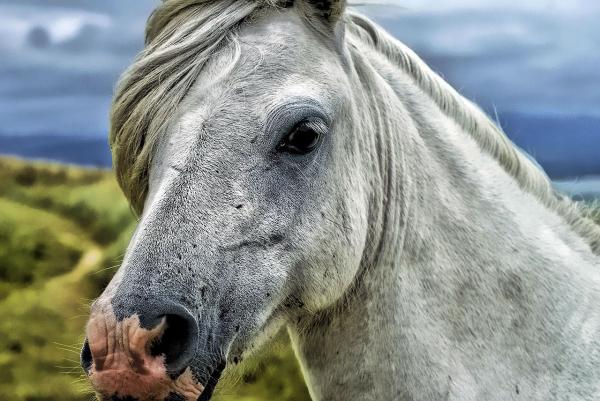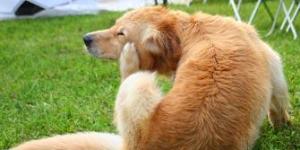Different Types of Horse Parasites



See files for Horses
The vast majority of species in the animal kingdom can be affected by parasites. Even parasites can have their own parasites, the latter known as hyperparasites. For an animal as large as a horse, there are various types of parasite which can cause infestation. Since a parasite is an organism which survives by taking resources from their host, there is a risk of causing disease. However, this doesn't always occur, so parasitism in itself is not necessarily detrimental to the horse's health. Parasitosis is when the parasite's interaction with the host causes disease.
As you can see already, different parasites will have different effects on the host. AnimalWised looks at the different types of horse parasites so we can know what harm may come to the animal. Equine parasites come in different forms, with worms being very common internal and flies common external parasites.
Types of parasites on horses
A parasite will adapt to the different tissues of the animal host it infests. Their ability to do so will largely depend on their size. This is why parasites will often be categorized according to the areas they affect. For example, some internal parasites are so small they can live in the the organism's cells and are known as intracellular parasites. A hemoparasite[1] is a type of intracellular parasite which lives in the blood of the animal.
Since there are millions of genera and species of parasites, taxonomic categories are used to help research and study them. Taxa are the groups in biology which classify living beings, associating them by their similarities and phylogenetic relation. The correct taxonomic classification of parasites has helped scientists study the effects of these organisms. However, because there are so many of them, knowing all the different types can become complicated.
In a more general sense, we can classify the types of horse parasites into two categories:
- Internal parasites (endoparasites)
- External parasites (ectoparasites)
Within each group we find various different types of parasites that affect horses. A parasite species will often bear a name relating to the host they most commonly affect, something which also apply to certain horse parasites.
Internal parasites in horses
Internal parasites, also called endoparasites, are organisms that live inside the animal. The type of tissue or organic material they live in varies, but some of the most common are those which live in the intestines, blood or organs.
If parasitosis occurs, the symptoms we can observe in the horse will vary according to their location. However, many symptoms will be shared by various equine parasite types. Some may be asymptomatic either at the beginning of their infestation or for their full life cycle. This means no obvious behavioral or physiological changes may occur.
Intestinal parasites in horses
One of the first symptoms we might observe in a horse with parasitosis is linked to their gastrointestinal tract. Diarrhea is one of the most common. These are often the result of intestinal parasites, since their defecation is so closely related to these organs. Other digestive conditions in horses which may result from intestinal parasites include colic, weight loss and peritonitis.
The most important intestinal parasites in horses are strongyles. These are the cause of equine strongyloidiasis (parasitosis in horses caused by nematodes of the order Strongylida). They are the major cause of diseases by intestinal parasites in horses. Strongyles can be classified into both large and small types, with larger varieties able to migrate along the digestive tract and affect other organs.
The most common types of strongyle parasite in horses include:
- Strongylus vulgaris: this parasite locates itself in the intestine of the horse and causes lesions in the tissue. This can seriously detract from the animal's quality of life. One of the most fascinating, yet deleterious, characteristics of this parasite is the fact it can migrate through the horses arteries. They can then attach themselves to the endothelium which can result in a life-threatening aneurysm. For this ability, they are also known as blood worms in horses.
- Strongyls equinus: part of the group of larger strongyles, they can also manifest migratory behaviors. In the case of this parasite, they can lead to pancreatitis and lesions on the liver.
- Strongylus edentatus: this parasite is associated with peritonitis in horses, although it has also been described leading to liver damage.
Aside from the strongyles, we need mention other species of intestinal parasites in horses as they are very relevant:
- Parascaris equorum: a type of roundworm in horses, this parasite causes cramps and is known for its high mortality in foals.
- Oxyuris equi: the parasitosis of this type of pinworm is characterized by pruritus in the anal area and tail. Restlessness and other signs of stress are both common and dangerous symptoms.
- Habronemiasis: this pathology caused by nematodes of the order Habronema and are most commonly found in the stomach. Although nematode worms parasitize internal organs, this species is also capable of causing equine cutaneous habronemiosis. This is one of the most studied skin conditions in horses. Within this order we can name Habronema megastoma, Habronema muscae and Habronema microstoma.

Hemoparasites in horses
The prefix ‘hemo-’ means ‘blood’, meaning a hemoparasite is one which lives in the blood of its host. They usually have a preference for certain cells, depending on the species. Some have also been reported to migrate freely in the bloodstream. The most studied types of hemoparasites in horses are:
- Trypanosomas: the cause of equine trypanosomiasis, they result in anemia which can become very serious. The species that parasites horses is called Trypanosoma evansi.
- Babesias: this is the cause of equine piroplasmosis, a malaria type disease which is sometimes known as ‘Texas fever’. Species of babesia most commonly parasitize the horse through tick as vectors. In horses we can find the species Babesia caballi and Babesia equi.
Pulmonary parasites in horses
There are parasites in horses that develop their evolutionary cycles in the airways of their respiratory system. In the case of the equine, the most important is a nematode called Dictyocaulus arnfieldi, which causes equine lungworm.
The main symptoms of lungworm in horses are coughing and nasal discharge. These can be exacerbated on colder days. The prognosis is generally favorable, but severe infestation can be damaging. They may result in respiratory distress and even pneumonia. They can also create hospitable conditions for bacterial infections. Foals or health-compromised horses are particularly vulnerable.
Kidney parasites in horses
There are some parasites capable of residing in the kidneys. In the case of horses, the most significant is Klossiella equi. This is responsible for equine renal coccidiosis. This pathology can lead to the animal developing kidney infections and alterations in the structure of the kidney.
The infestation of horses can come through different vectors. However, the most common is from ingestion of affected material. Eggs are consumed by the horse which then develop in various tissues. Since horses spend so much time in large spaces, prevention of intestinal parasites can be difficult. This is why horse owners need to be vigilant for any signs of symptoms of internal parasites in horses. One of the most common is the presence of larvae or worms in their feces.
External parasites in horses
External parasites, or ectoparasites, are organisms that live outside the host organism. They are usually found in the skin and can cause very dangerous for the animal they feed on. These include insects, mites, arachnids, etc., but the most important external parasites in horses can be classified as follows:
Parasitical flies on horses
Horseflies are a species of fly which belong to the Tabanidae family. They are hematophagous, meaning they feed on blood. Some species are particular to horses. Their sting is quite painful, so it causes stress problems to the affected horse. The most common are:
- Stomoxys calcitrans: it is commonly called the stable fly and also has hematophagous habits. It is attracted to any warm-blooded animal (including humans), which is why it should be considered an important external parasite in the study of horse parasites.
- Gasterophilus: also known as bot flies. An infestation is caused by an external fly laying eggs in wounds or other orifices. The eggs then lay in the flesh of the horse and the ensuing larvae eat through the tissue. This is one of the most common parasites in horses. While they can survive without treatment, if the infestation grows large enough, the horse's well-being is under threat. The most important ones that affect horses are: G. haemorroidalis , G. intestinalis and G. nasalis.
Ticks on horses
The most common tick species in horses are the following:
- Dermacentor nitens: it is a species belonging to the family Ixodidae (hard ticks) and is one of the ticks that parasitize horses. This tick serves as a vector for other parasites (such as babesia), causing different systemic diseases such as equine pyroplasmosis.
- Amblyomma cajennense: it also belongs to the family of hard ticks and is one of the species that is most found in horses. It causes anemia problems and is well known worldwide for being responsible for rocky mountain spotted fever. They are sometimes known as the cayenne tick.
We will notice that the horse has ticks if we observe that it feels itchy in certain areas. When analyzing this area, we should be able to see the tick, which we will need to remove with tweezers. We need to be very careful so that the tick doesn't release toxins into the bloodstream of the horse. If we feel like we are unable to do this ourselves, we should seek a specialist veterinarian.

Treatment of parasites in horses
For obvious reasons, each parasitic species will have different methods of control and treatment. While prevention is difficult, maintaining proper hygiene and regular checkups with a specialist veterinarian are important. This should happen from birth. If parasitosis is diagnosed, antiparasitic medication will likely be prescribed by the vet. The type of drug will depend on the type of parasite.
If there is a high number of flies present, further protection may be required. This may include a special mask which is used to protect from further infestation (see photo above). This may even be used as a preventive method in areas where there is a large population of flies, especially those from the order Diptera.
The prognosis for the majority of cases is favorable, but it internal parasite can be tricky. Parasitosis can progress without showing any external signs, only doing so when a lot of damage has been done to the animal's tissues.
After antiparasitics have been administered, the veterinarian will implement a course of deworming which will help to avoid future infestations. Internal deworming schedules will usually come in the form of tablets or syrup. For external parasites which affect the skin, both topical and oral treatments may be used. A vaccination plan will also need to be implemented. This is another reason it is so important to take the horse to a specialist veterinarian right after they are born.

This article is purely informative. AnimalWised does not have the authority to prescribe any veterinary treatment or create a diagnosis. We invite you to take your pet to the veterinarian if they are suffering from any condition or pain.
If you want to read similar articles to Different Types of Horse Parasites, we recommend you visit our Parasitic diseases category.
1. Hall, C. M., et al. (2013). Genetic characterization of Theileria equi infecting horses in North America: evidence for a limited source of U.S. introductions. Parasites & Vectors, 6(35).
https://parasitesandvectors.biomedcentral.com/articles/10.1186/1756-3305-6-35
- Cordero del Campillo, M., & Rojo Vázquez, F. (1999). Veterinary Parasitology. McGraw-Hill Interamerican Editorial.
- Flores, A. & Rivero, E. (2016). Prevalence of gastrointestinal nematodes in horses of the JJ Ranch stable El Alto sector of the Monseñor Iturriza municipality of Falcón state. UNEFM.
- Quiroz, R. H. (1984). Parasitology and parasitic diseases in domestic animals. Editorial Limusa.







